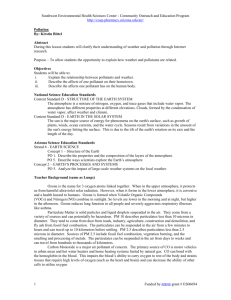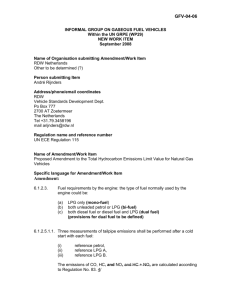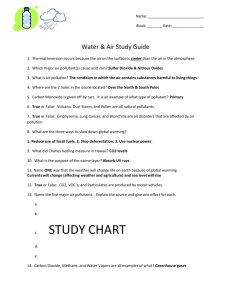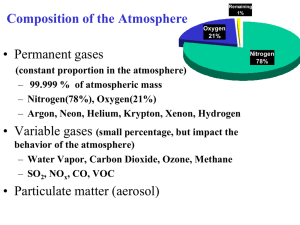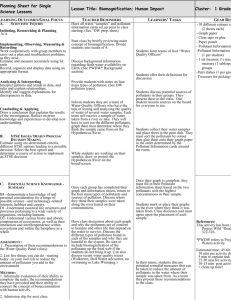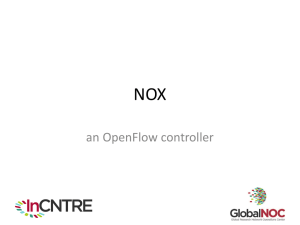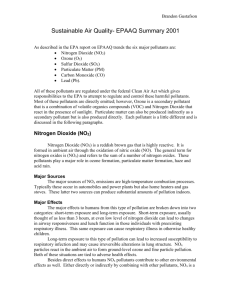WongDissertation Pro.. - UCL Department of Geography
advertisement
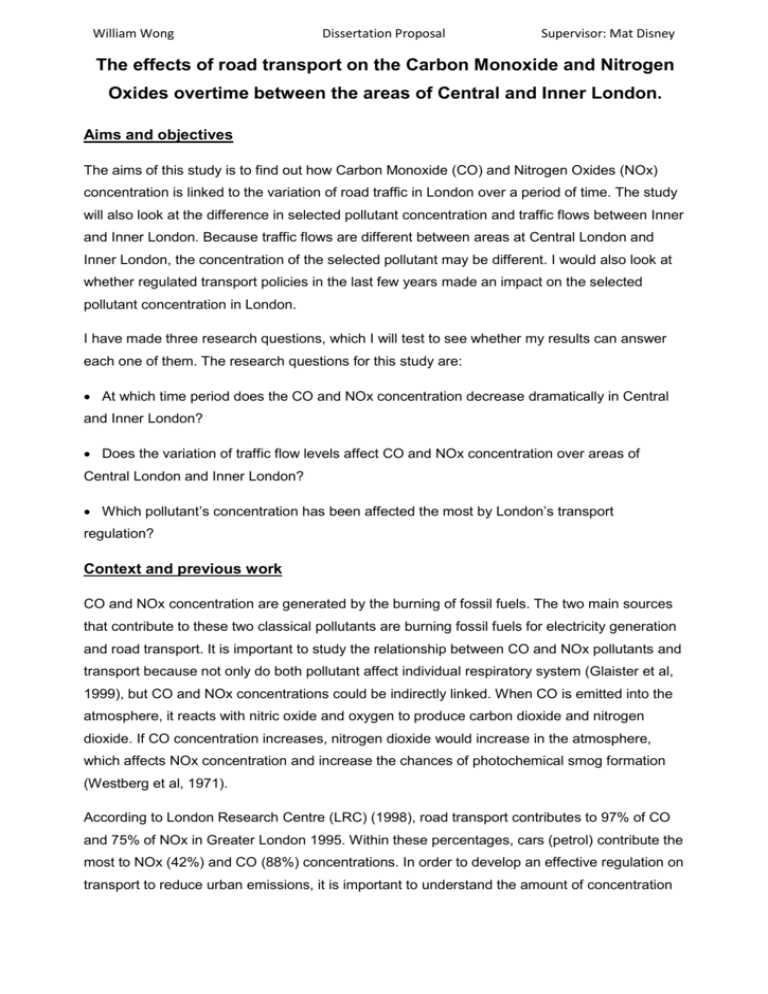
William Wong Dissertation Proposal Supervisor: Mat Disney The effects of road transport on the Carbon Monoxide and Nitrogen Oxides overtime between the areas of Central and Inner London. Aims and objectives The aims of this study is to find out how Carbon Monoxide (CO) and Nitrogen Oxides (NOx) concentration is linked to the variation of road traffic in London over a period of time. The study will also look at the difference in selected pollutant concentration and traffic flows between Inner and Inner London. Because traffic flows are different between areas at Central London and Inner London, the concentration of the selected pollutant may be different. I would also look at whether regulated transport policies in the last few years made an impact on the selected pollutant concentration in London. I have made three research questions, which I will test to see whether my results can answer each one of them. The research questions for this study are: At which time period does the CO and NOx concentration decrease dramatically in Central and Inner London? Does the variation of traffic flow levels affect CO and NOx concentration over areas of Central London and Inner London? Which pollutant’s concentration has been affected the most by London’s transport regulation? Context and previous work CO and NOx concentration are generated by the burning of fossil fuels. The two main sources that contribute to these two classical pollutants are burning fossil fuels for electricity generation and road transport. It is important to study the relationship between CO and NOx pollutants and transport because not only do both pollutant affect individual respiratory system (Glaister et al, 1999), but CO and NOx concentrations could be indirectly linked. When CO is emitted into the atmosphere, it reacts with nitric oxide and oxygen to produce carbon dioxide and nitrogen dioxide. If CO concentration increases, nitrogen dioxide would increase in the atmosphere, which affects NOx concentration and increase the chances of photochemical smog formation (Westberg et al, 1971). According to London Research Centre (LRC) (1998), road transport contributes to 97% of CO and 75% of NOx in Greater London 1995. Within these percentages, cars (petrol) contribute the most to NOx (42%) and CO (88%) concentrations. In order to develop an effective regulation on transport to reduce urban emissions, it is important to understand the amount of concentration William Wong Dissertation Proposal Supervisor: Mat Disney that road transport emits to the atmosphere and which type of vehicles contribute the most to road traffic emissions (Holman, 1999). Apart from cars (petrol), other transport needs to be taken into account (Lorries and diesel vehicles) because they contribute to the emissions of London’s air pollution. London Scientific Services created a report named “Air pollution associated with transport in London”, which was published in 1990 for the London Planning Advisory Committee (LPAC, 1990). The report looks at nine different air pollutant including CO and NOx and relates their concentration levels to the WHO guidelines in order to see if the pollutant levels are over the limit. It looks at how different types of vehicles (e.g. HGV, Petrol cars) contribute to the various pollutants that exist in London. LPAC looks at the pollutant levels in order to provide some suitable strategies to manage pollution problem like the Luxembourg agreement (European Community Council Directive, 1987) and technical improvement i.e. catalytic converts. Small and Kazimi (1995) focused its research on six different air pollutants (CO, NOx, ozone, SO2, VOCs and PM). The author looks into the cost of pollutant emissions by using direct estimation of damages and tries to put a link between air pollution and adverse consequences in relation to economic values. Rather than focusing on the link between the primary pollutants and road transport, they take account of other features nearby that may affect the pollutants’ concentration such as the topography and atmospheric conditions. Los Angeles was used a s a case study in this research, where they compare their air emissions result with human health There is also a report on the transport and health of London by Glaister et al (1999), which was researched for NHS executive. The report provides a very detailed analysis of accidents, different air pollutants and mortality in relation to transport and providing solution to reduce the issues in the report such as transport policies. In this report, my only interests are the air pollutant and transport information and management because those are my focused area of study. The author concentrates on the five different air pollutants (Same as Small and Kazimi research but they did not include ozone). The report looks at the chemistry of each pollutant, the source of emission relating to transport and how it affects individual health. They collected secondary data and used time-series analysis to link the concentrations with transport datasets. Using these data, the author directly compares the results to the mortality figures in London to show whether London’s air pollution is responsible for most health issues. Glaister et al also looked at transport strategies mentioned in different research papers and linking it to London’s current management. Transport management strategies and modelling management regulation from other papers is essential to compare it effectiveness on controlling traffic and if it is suitable to apply to London today (compared to congestion charge). Strategies William Wong Dissertation Proposal Supervisor: Mat Disney such as modelling of the outcome of CO2 if fuel tax were increase by 42% or car ownership taxes were increased by 470% (Koopman, 1995). My proposed dissertation would contribute to the research of this report by looking at the more recent pollutant and transport records and comparing the Central London and Inner London regions to further develop the LPAC report (1990). It would contribute to knowledge of current pollutant level (CO and NOx) and show whether current transport regulation has made any impacts on pollutant concentrations. The audience of my proposed dissertation would be the public who are interested in traffic and air pollution as well as environmental agency and Transport of London (Tfl). Organisation such as Environmental Agency and Tfl could use the information and analysis on my dissertation to propose future management on transport and air quality in London by comparing my results with future datasets. Apart from the future, my dissertation is also useful to look into the effectiveness of current transport policies because Tfl could improve their current regulation on transport, if the results of my dissertation do not make a huge impact during the time of regulation. Research methods For my research, I will be collecting secondary data for transport and for pollutant concentrations for CO and NOx. I chose to use secondary sources to collect my data because there are existing recorded data sets for various pollutant and transport in different areas of London. It is not necessary to collect the primary data when there are records of these data available (from monitoring sites) (Sorensen et al, 1996) in areas such as Bloomsbury and Bexley in London. I have already collected online datasets for road traffic statistic and annual average daily flows dating from 1993 to 2007, for all London councils from the Department of Transport (Dft). Therefore, I will try to collect CO and NOx concentration datasets from 1993 to 2007 for direct comparison. I have chosen to collect the datasets during this time period because I can compare the selected pollutant concentration and transport data before and after the regulation of Congestion Charge and Low Emission Zones. Therefore, finding NOx and CO datasets can determine whether the regulation has made any impact on the concentrations. William Wong Dissertation Proposal Supervisor: Mat Disney I have also collected time series datasets for CO and NOx concentrations AEA (which is a part of DEFRA) through the internet. However, AEA has datasets available for only seven regions within London, where five regions are in Central London and the three remaining are located in Inner London (See figure 1). Therefore, I am going to combine the online datasets from London Air Quality Network (LAQN) with the AEA and select to produce an even comparison of ten regions between Central and Inner London (Five monitoring sites in Central London and five from Inner London area). The LAQN has 26 different sites that have recorded both NOx and CO concentrations. Figure 1 would provide an outline to locate whether a monitoring site is located in Central or Inner London area. However, some regions do not contain data as far as 1993, which can be a problem when comparing with traffic flow data since I have datasets from 1993 to 2007. This is one of the potential problems that my study may encounter because there are specific monitoring sites that does not have a record of past pollutant concentration available. So, there is a limited choice to which datasets I could choose to compare. However, if I cannot find five monitoring sites for Central and Inner London due to lack of recording dating back to 1993, then I will have to reduce the time period (i.e. 1996 to 2007) in order to find available datasets to analysis. William Wong Dissertation Proposal Supervisor: Mat Disney Another problem that I may encounter during my study is the selection of monitoring sites to represent the two areas. I will pick datasets from monitoring sites that are either in different councils or that are not clustered together with other sites. Site selection is important because if I use datasets from two monitoring sites that are clustered together, the recordings are likely to be similar (See Figure 2). Figure 2 is an example map which shows where the monitoring sites are location. Some CO monitoring sites on figure 2 is clustered close together. So, if I already have a dataset for one of the monitoring sites in the clustered region, it is not necessary to have another dataset taken from that region again. I would try and find sites that are located in North, East, South and West London, in order to show how the selected pollutant concentration varies at different geographical locations. The LPAC report (1990) notes that stable weather conditions in London (with light winds and clear skies) could trap vehicle emissions in a stable air mass near the ground. The weather patterns during the recording of the pollutant concentration are unknown, so there may be issues with the accuracy of these data from the monitoring sites. However, this issue is minimised by using daily mean dataset because it would average out the variation of data which may have been affect by the conditions of that weather during each day. Data analysis For my selected pollutant concentrations, I will be using Time-Series analysis on CO and NOx concentrations on the 10 chosen sites. Because the dataset are recorded as daily mean, I will have to change the daily mean datasets to monthly, in order to see the monthly variation of CO and NOx concentration. The Time-Series graph allows detail analysis of the selected concentration over a period of time. It provides a clear representation of the datasets that I have collected at different monitoring sites. William Wong Dissertation Proposal Supervisor: Mat Disney Pollutant Concentration Maps would also be used to show CO and NOx concentration across London. To generate this map, the monthly datasets will be added up to produce yearly data. The reason for using yearly data is because I want to visually analyse how the selected pollutant changes before and after transport regulation in London. The GIS points should be located on the website of AEA or LAQN, which I can use to find the monitoring site location on the pollutant concentration map. If they are not located on the site, I will email AEA and LAQN to provide the GIS location points. Linear regression will be used to compare traffic daily flow and CO and NOx concentrations. The reason for using linear regression on these dataset is because it would show the relationship between the traffic flow data and selected pollutant concentration. This will also be used to analyse how management strategies on transport has affected the concentration levels of CO and NOx e.g. 2003 with the London Congestion Charge (Tfl (1), 2006). Ethics The ethical issue this study may contain is the use of secondary data from various organisations. Eventhough the data I have collected and will be collecting is available on the internet, but the organisation who distributes would not like the users to assign these data to third party without their consent. Therefore, I will send a copy of a completed dissertation to each organisation who I have used the dataset for my study. These organisations include the Department of Transport, AEA and NAEI (who are on behalf of DEFRA). Expected outcomes and significance The results from my study are expected show a link between transport and CO and NOx. Over time, as car ownership in UK increases from population increase, CO and NOx concentration will still be an environmental issue in London (Dft, 1997). I predict that the selected pollutants concentration should decrease dramatically after 2003 because London introduced congestion charge in 2003, which would reduce the amount of road vehicles users promote use alternative transport such as trains. This information is useful to the readers who are environmentalist or organisation such as AEA because this research question could show London’s pollutant concentrations changes over time. It could also be used to link with other pollutant levels that may be affected indirectly such as Ozone. There should be a high variation between the traffic flow of Central and Inner London because most of the public transport and busy roads are located near the centre of London. Since most services are located in Central London and residential areas are mainly found in Inner London, the data are expected to show high daily traffic flow in Central London and Low daily traffic flows in Inner London. Therefore, CO and NOx concentration should be lower in Inner London than Central London. However, the results for this research question may be affected by commuter William Wong Dissertation Proposal Supervisor: Mat Disney travelling from areas outside of Greater London. I may expect high levels of NOx and CO concentrations at the West of London because around 60%-80% of commuters from West of Greater London drive into the city by car (40%-60% around the other areas) (Tfl (2), 2006). The outcome of this research question would provide the audience useful information to which areas of London produces the most pollutant concentration of CO and NOx. Organisation such as Tfl could create new regulations for those areas to reduce traffic flow across the high CO and NOx concentration areas. CO concentrations should be affected the most when transport regulation is introduced. Road transport contributes a higher percentage of CO in London than NOx (LRC, 1998), which means the regulation on transport should reduce CO concentration more than NOx in London. The outcome of this research question allows the organisations such as Tfl to take account of which pollutant would be affected the most by transport regulation. This would show whether their regulation such as Low emission zone in central London (Tfl, 2004) has taking any effect on CO and NOx concentrations and if more regulation is needed to reduce the concentrations. References Atmospheric Research and Information Centre (ARIC) “Atmosphere, Climate & Environment Information Programme Factsheet 4: The Key Air Pollutants”, Manchester Metropolitan University Glaister et al, (1999) ‘Transport and Health in London: a report for the NHS executive, London’, London, Mayor of London: “http://www.london.gov.uk/lhc/docs/lhs/rapidreviews/transport.pdf” Koopman, GJ (1995) ‘Policies to reduce CO2 emissions from cars in Europe: a partial equilibrium analysis’, Journal of Transport and Economics and Policy, 29, 1, 53-70 London Air Quality Network (LAQN) - Environmental Research Group, King's College London: “http://www.londonair.org.uk/” London Planning Advisory Committee (LPAC) (1990) Airpollution associated with transport in London, Romford, LPAC London Research Centre (LRC) (1998) Greater London Atmospheric Emissions Inventory, London, LRC William Wong Dissertation Proposal Supervisor: Mat Disney Small, K.A and Kazimi, C (1995) ‘On the costs of air pollution from motor vehicles’, Journal of Transport Economics and Policy, 29, 1, 7-32 Sørensen et al, (1996) ‘A Framework for Evaluation of Secondary Data Sources for Epidemiological Research’, International Journal of Epidemiology, 25, 2, 435-442 Tfl (Transport of London) (2004) ‘The Low Emission Zone Cleaner air for Greater London’, Transport of London: http://www.tfl.gov.uk/assets/downloads/LEZ/LEZ-information-leaflet.pdf Tfl (1) (2006) ‘Congestion Charge Four Year Programme’, Mayor of London: http://www.tfl.gov.uk/assets/downloads/Four_Year_Programme_2006.pdf Tfl (2) (2006) ‘London Travel Report 2006’, Mayor of London: “http://www.tfl.gov.uk/assets/downloads/corporate/London-Travel-Report-2006final.pdf” Westberg et al, (1971) ‘Carbon Monoxide: Its Role in Photochemical Smog Formation’, Science, 171, 3975, 1013-1015 Wikipedia (2005) Central London, Central London and Inner London: “http://en.wikipedia.org/wiki/Central_London”
